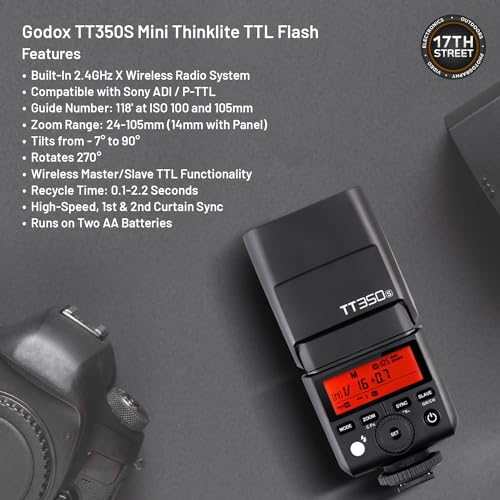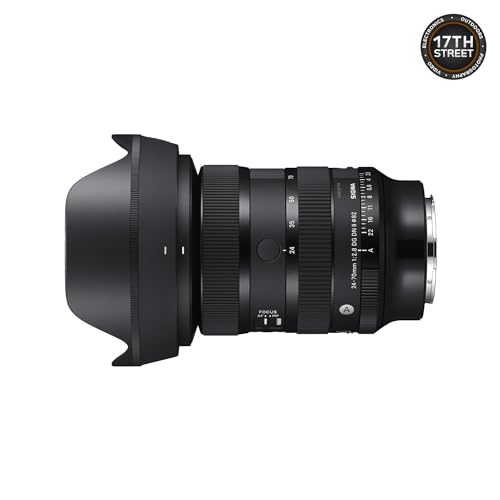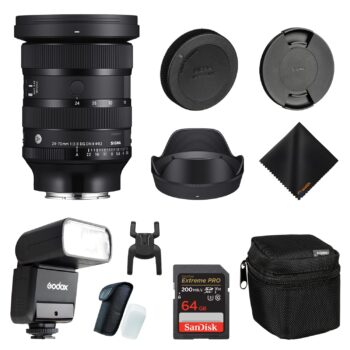Sigma 24-70mm f/2.8 DG DN II Art Bundle Technical Review: A New Benchmark in Performance and Value
Introduction: The Relentless Pursuit of Optical and Mechanical Perfection
In the demanding world of professional and enthusiast photography, the 24-70mm f/2.8 standard zoom is the undisputed workhorse. It is the lens that bears the weight of expectation, the single most critical optic in a creator’s bag, required to deliver uncompromising sharpness, speed, and versatility across a vast range of disciplines. Sigma’s “Art” line has long been celebrated for challenging the status quo, offering optical performance that often meets or exceeds that of first-party manufacturers at a more accessible price. The original Sigma 24-70mm f/2.8 DG DN Art was a landmark lens, a testament to this philosophy. However, the relentless pace of camera technology, with its ever-increasing sensor resolutions and lightning-fast autofocus systems, demanded an evolution. The result is the Sigma 24-70mm f/2.8 DG DN II Art, a lens that is not merely an update but a profound and comprehensive re-engineering of a modern classic.
This second-generation flagship is a direct response to the needs of today’s hybrid creators. It is a lens forged in the pursuit of perfection, addressing every potential critique of its predecessor with surgical precision. It is smaller, lighter, and faster, yet optically more advanced. Sigma’s engineers have implemented a new, cutting-edge autofocus motor, the High-response Linear Actuator (HLA), for a quantum leap in AF speed and tracking performance. They have refined the optical formula to further enhance resolving power, ensuring it can satisfy the most demanding high-megapixel sensors. And in a crucial nod to filmmakers, they have added a physical, de-clickable aperture ring, providing the tactile control that is essential for professional video production. This is a lens that promises to be the new benchmark, a versatile tool designed to empower both photographers and filmmakers to unleash their full creative potential.
This review goes a step further by analyzing not just the lens in isolation, but a thoughtfully curated complete creator’s bundle. This package pairs the groundbreaking lens with a set of essential, high-performance accessories: the compact and powerful Godox TT350S Mini TTL Flash, a professional-grade SanDisk 64GB Extreme PRO memory card, and other critical maintenance items. In this exhaustive technical review, we will perform a granular dissection of every component of this bundle. We will analyze the advanced optical physics and mechanical engineering of the Sigma Art II lens, deconstruct the sophisticated wireless protocols of the Godox flash, and evaluate the data-transfer architecture of the SanDisk memory card. This is a deep dive for the discerning creator who understands that a great lens is the heart of a system, and that a well-chosen system is the key to unlocking a seamless and powerful workflow.

A Deep Dive into the Bundle’s Key Features: A Component-by-Component Technical Analysis
The true value of this package lies in the synergy of its high-quality components. We will now analyze each piece of equipment, starting with the star of the show, to understand its specific technologies and contributions to a professional workflow.
The Heart of the System: The SIGMA 24-70mm F2.8 DG DN II | Art Lens
This lens is a marvel of modern optical engineering, representing a significant advancement in multiple key areas.
-
Optical Formula and Resolving Power: A Symphony of Specialized Glass
The foundation of the Art II is its completely redesigned optical formula, consisting of 19 elements in 15 groups. This complex design is necessary to maintain extreme sharpness across a 2.9x zoom range with a bright f/2.8 aperture. The key to its “improved resolving power” is the strategic use of exotic glass. The formula incorporates **six SLD (Special Low Dispersion) elements** and five aspherical elements. From an optical physics perspective, SLD glass is a critical component for achieving high fidelity. When light passes through a standard lens element, different wavelengths (colors) bend at slightly different angles, a phenomenon known as chromatic dispersion. This causes the colors to focus at slightly different points, resulting in **chromatic aberration**, which manifests as distracting purple and green fringing in high-contrast areas of an image. SLD glass has a very low dispersion index, meaning it minimizes this color separation. By using six of these elements, Sigma engineers have been able to achieve an exceptionally high degree of chromatic aberration correction, leading to cleaner, sharper images with truer color rendition. The five aspherical elements, with their complex non-spherical surfaces, work to correct for other aberrations like coma, astigmatism, and field curvature, ensuring that this high level of sharpness is maintained not just in the center, but across the entire full-frame image area. This optical prowess ensures the lens can resolve the fine details required by the latest 40, 50, and 60+ megapixel sensors.

-
The Autofocus Revolution: The High-response Linear Actuator (HLA)
The most significant mechanical upgrade is the implementation of Sigma’s new **HLA (High-response Linear Actuator)** autofocus motor. This is a powerful, electromagnetic linear motor system. It operates by using magnetic force to directly and silently drive the focusing group of lens elements along a rail, with no gears or intermediate linkages. This direct-drive mechanism is incredibly efficient and allows for extremely fast and precise movements. Compared to the stepping motor (STM) used in the previous generation, the HLA provides a dramatic increase in both speed and thrust. This results in an autofocus performance that is more than **three times faster** according to Sigma’s measurements. This quantum leap in speed is essential for keeping pace with the advanced subject-tracking capabilities of modern mirrorless cameras like those from Sony. For a sports or wildlife photographer, this means the lens can acquire focus and track a fast-moving subject with far greater tenacity and a higher keeper rate during high-speed bursts. For videographers, the linear motor is virtually silent and provides the smooth, precise control needed for cinematic focus pulls.
-
Hybrid-Shooter Ergonomics: The Physical Aperture Ring
In a direct response to feedback from the filmmaking community, the Art II now includes a physical **aperture ring**. This provides a direct, tactile method for controlling the lens’s rounded 11-blade diaphragm. This is a massive ergonomic improvement for videographers, who can now adjust their exposure by feel without having to rely on a camera’s command dial. Crucially, the ring includes a “click” switch. For photographers, the tactile clicks provide satisfying, detented feedback for each 1/3-stop adjustment. For filmmakers, the ring can be “de-clicked,” allowing for completely smooth, silent, and stepless iris transitions while recording—a non-negotiable feature for professional cinematography. The aperture ring also features a lock switch to prevent it from being accidentally moved from the ‘A’ (Auto) position during photographic use.

-
Optimized for Portability: Smaller and Lighter Construction
Despite adding a physical aperture ring and a more powerful motor, Sigma’s engineers have achieved a remarkable feat of miniaturization. The Art II is **7% smaller** in overall volume and **10% lighter** (weighing 735g) than its predecessor. This was accomplished through a more efficient optical design, a more compact HLA motor, and the use of advanced, lightweight TSC (Thermally Stable Composite) materials in the barrel construction. This reduction in size and weight has a tangible ergonomic benefit, improving the overall balance of the lens on a mirrorless body and reducing user fatigue during long days of handheld shooting, making it a more agile and enjoyable tool to use.
The Lighting Powerhouse: The Godox TT350S Mini Thinklite TTL Flash
This compact flash is an essential accessory that elevates the creative potential of the entire kit.
-
Advanced Flash Protocols: TTL and High-Speed Sync (HSS)
The TT350S is not a simple manual flash. It fully “supports Sony ADI / P-TTL.” TTL stands for Through-The-Lens metering. In this mode, the flash fires a brief pre-flash, the camera’s meter reads the reflected light through the lens, and then instantly calculates the precise power output needed for a perfect exposure. This automates the complex task of flash exposure, making it incredibly easy to get great-looking, well-lit shots. The flash also supports **High-Speed Sync (HSS)**. Normally, a camera’s shutter speed is limited when using a flash (typically to 1/250s). HSS allows you to bypass this limit and shoot with flash at any shutter speed, all the way up to 1/8000s. This is a game-changer for outdoor portrait photography, as it allows you to use a wide aperture (like f/2.8 on the Sigma) to blur the background, while simultaneously using a fast shutter speed to control the bright ambient light and a flash to perfectly illuminate your subject.

-
Wireless Freedom: The 2.4GHz Radio System
The flash’s most powerful feature is its built-in **2.4GHz radio system**. This allows the flash to be used off-camera for more creative and flattering lighting, without needing a direct line of sight. It can function as a wireless commander to control other Godox flashes, or as a slave unit triggered by another flash or a dedicated Godox X-series transmitter. The system offers a reliable **328-foot range**, with access to 16 channels and 3 groups, providing a robust and interference-free wireless setup that is the foundation of modern off-camera flash photography.
The Data Engine: The SanDisk 64GB Extreme PRO UHS-I SDXC Memory Card
-
Professional Speed and Reliability
A high-performance camera and lens are useless without a memory card that can keep up. This bundle includes a professional-grade **SanDisk 64GB Extreme PRO** card. From a technical standpoint, its speed class ratings are critical. It is a **UHS-I** card, and it boasts a **UHS Speed Class 3 (U3)** and a **Video Speed Class 30 (V30)** rating. Both U3 and V30 guarantee a minimum *sustained* write speed of **30 MB/s**. This is a non-negotiable requirement for modern hybrid cameras. This sustained speed is essential for recording high-bitrate **4K video** without dropping frames or having the recording unexpectedly stop. It is also critical for **burst photography**. When you shoot a rapid sequence of high-resolution RAW images, the camera’s internal buffer fills up quickly. A fast card like this allows the buffer to clear rapidly, enabling longer continuous bursts. With read speeds of up to 200 MB/s (with a compatible reader), transferring your files to a computer is also exceptionally fast, saving valuable time in post-production.

Pros: The Undeniable Technical Strengths of the Bundle
- Flagship-Level Optical Performance: The Sigma Art II lens delivers exceptional corner-to-corner sharpness and beautiful bokeh, suitable for the most demanding professional applications.
- Revolutionary Autofocus Speed: The lens’s HLA motor provides a massive leap in AF speed, making it a top-tier performer for tracking fast-moving subjects.
- True Hybrid Design: The inclusion of a de-clickable aperture ring on the lens makes it a superb tool for both high-end photography and professional cinematography.
- Complete Creative Lighting System: The Godox TT350S flash provides TTL automation, HSS for creative control, and a robust off-camera radio system, vastly expanding creative possibilities.
- Professional-Grade Data Storage: The SanDisk Extreme PRO card is fast enough to handle the 4K video and high-speed burst shooting that this lens and modern cameras are capable of.
- Exceptional All-in-One Value: This bundle provides a complete, high-performance starter kit for a professional or serious enthusiast at a price point that is significantly less than purchasing all components separately.
Cons: Important Technical Considerations and Limitations
- Lack of Lens-Based Image Stabilization: Unlike some competitors, the Sigma lens does not have its own optical stabilization (OS). It relies entirely on the In-Body Image Stabilization (IBIS) of the camera body, which may be a consideration for users with non-stabilized Sony cameras.
- Flash Power Limitations: The Godox TT350S is a “Mini” flash. While powerful for its size, its guide number and recycle times will not match those of a full-sized, professional speedlight.
- External Zoom Mechanism on Lens: The lens barrel extends when zooming, a design that can be less robust and more prone to dust intrusion than an internal zoom lens.
- 64GB Card Capacity: While fast, a 64GB card can fill up quickly when shooting high-bitrate 4K video or extensive RAW bursts. Heavy-volume shooters may need to invest in larger cards.
Conclusion: The Ultimate High-Performance Starter Ecosystem
The Sigma 24-70mm f/2.8 DG DN II Art Lens Bundle represents far more than the sum of its parts. It is a thoughtfully curated, technically superior ecosystem that provides a creator with the foundational tools for professional-grade image-making. The lens itself is a triumph of engineering, a product that successfully synthesizes breathtaking optical quality, revolutionary autofocus speed, and true hybrid ergonomics into a lighter, more compact form factor. It is a lens that instills absolute confidence and is poised to become the new workhorse standard for the Sony E-mount system.
The genius of this bundle is that it complements this flagship lens with accessories that are not mere throw-ins, but genuinely powerful, performance-matched tools. The Godox flash unlocks the world of creative lighting, while the SanDisk card provides the essential speed and reliability to handle the massive amounts of data the lens and camera will produce. This is not a beginner’s kit; it is a professional’s starting block. For the wedding photographer, the event videographer, the commercial content creator, or the serious enthusiast who is ready to invest in a no-compromise system, this bundle offers an unparalleled combination of performance, capability, and sheer value. It is a powerful, intelligent, and complete solution that earns our highest technical recommendation.
Frequently Asked Questions (FAQs)
- Q1: What is the main technical difference between the Sigma 24-70mm DG DN II and the Sony 24-70mm F2.8 GM II?
- A: Both are flagship lenses. The primary differences are in a few key areas. The Sony GM II includes its own optical stabilization (OSS), whereas the Sigma does not. The Sony uses four XD Linear motors, while the Sigma uses a single, powerful HLA motor; both provide exceptional speed. The Sigma includes two AFL buttons, while the Sony has one. The Sigma is also significantly more affordable. Optically, both are considered to be among the sharpest standard zooms ever made, with minor differences that are often a matter of photographer preference.
- Q2: What does “HLA” stand for and how is it technically different from Sony’s “XD Linear Motor”?
- A: HLA stands for High-response Linear Actuator. Both HLA and Sony’s XD (Extreme Dynamic) Linear Motor are types of electromagnetic linear motors. They use magnetic force for direct, gearless actuation of the focusing group. The main difference is in the specific proprietary design, architecture, and power of the magnets and coils. Both technologies aim to achieve the same goal: extremely fast, silent, and precise autofocus performance. The Sigma’s move to HLA represents a massive leap in speed over its previous motor types.
- Q3: Is the Godox TT350S powerful enough for professional use?
- A: It depends on the use case. For on-camera fill flash, small-group portraits, and as part of a multi-light wireless setup, it is absolutely a professional tool. Its compact size makes it ideal for event photographers who need to stay mobile. However, for overpowering the sun in bright daylight or for lighting large groups or spaces, a more powerful, full-sized flash like a Godox V1 or V860III would be necessary.
- Q4: Why are V30 and U3 ratings on a memory card so important for video?
- A: These ratings guarantee a MINIMUM sustained write speed. Recording 4K video generates a massive, continuous stream of data. A card without a V30/U3 rating might have high peak speeds, but it may not be able to sustain that speed, causing the camera’s buffer to overflow and the recording to stop unexpectedly. The V30 rating guarantees the card can handle a continuous data stream of at least 30 MB/s, which is a requirement for high-quality 4K recording on most modern cameras.
- Q5: What does “DG DN” in the lens name signify?
- A: This is Sigma’s designation system. “DG” indicates that the lens is designed to cover a full-frame image sensor. “DN” indicates that the lens is designed specifically for the short flange distance of mirrorless camera systems. A DG DN lens is therefore a “Full-Frame Mirrorless” lens.
- Q6: Since the lens doesn’t have stabilization, is it bad for video?
- A: Not at all, provided you are using it on a camera body with In-Body Image Stabilization (IBIS), which all modern full-frame Sony Alpha cameras have. The camera’s IBIS will provide very effective 5-axis stabilization for both stills and video. The lack of optical stabilization in the lens was a deliberate engineering choice by Sigma to make the lens smaller, lighter, and more optically simple, knowing that the target camera bodies already had excellent stabilization.
See more posts in the category Lens.







